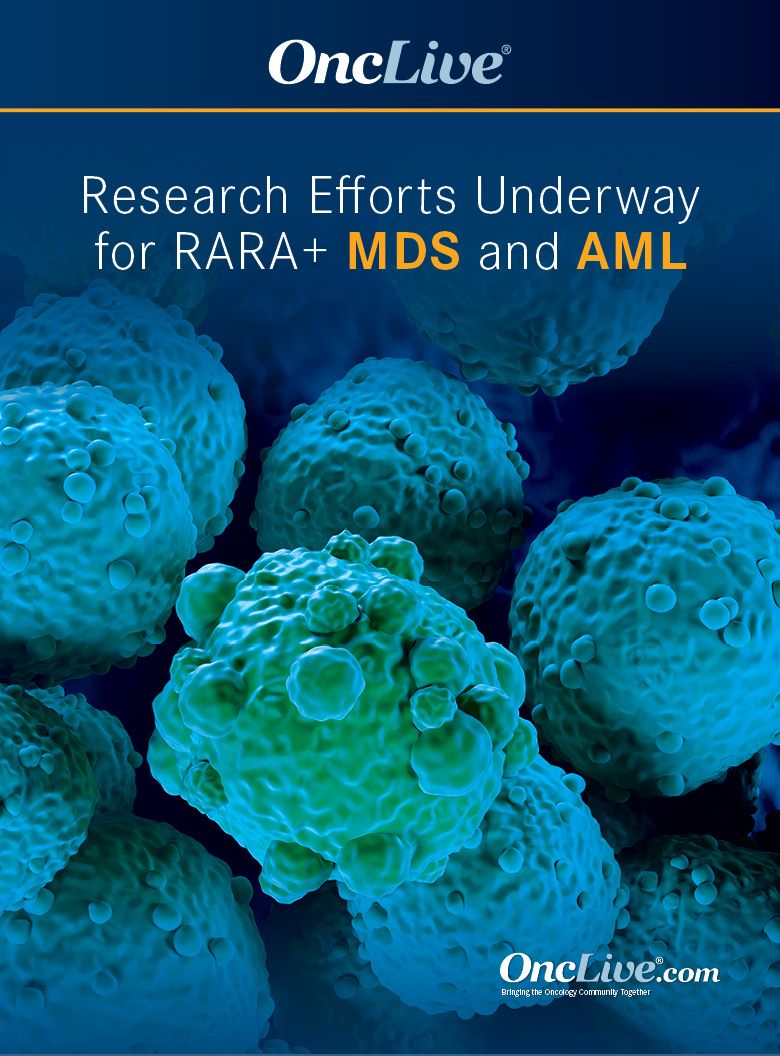Publication
Article
Investigators Explore RARA Overexpression With Tamibarotene in Higher-Risk MDS
Author(s):
Risk stratification for patients with myelodysplastic syndrome have afforded those with asymptomatic or low-risk disease treatment pathways that can be navigated using a variety of patient characteristics. However, treatment algorithms for patients with higher-risk disease are limited to allogeneic transplant or treatment with hypomethylating agents.
Amy Elizabeth Dezern, MD

Risk stratification for patients with myelodysplastic syndrome (MDS) have afforded those with asymptomatic or low-risk disease treatment pathways that can be navigated using a variety of patient characteristics. However, treatment algorithms for patients with higher-risk disease are limited to allogeneic transplant or treatment with hypomethylating agents, such as azacitidine (Vidaza) or decitabine (Dacogen).1
High symptom burden, common among patients with MDS, typically presents hurdles to enrollment to clinical trials and treatment modalities are often aimed at reducing this burden for patients. Novel therapies for this patient population are limited with the approval of an oral combination of decitabine and cedazuridine (Inqovi) representing the first approval for patients in over a decade.1,2
Early efforts to integrate targeted approaches for patients with higher-risk MDS have shown that those with RARA overexpression may represent a novel subset of patients who can benefit from targeted treatment strategies.
“Approximately 30% of [patients with] MDS or [acute myeloid leukemia] AML are identified as RARA-positive using a peripheral blood based biomarker test,” Amy Elizabeth Dezern, MD, said in a presentation during the 2022 ASCO Annual Meeting. “Tamibarotene is a next-generation retinoid differentiation agent designed to be a more potent and selective RARA agonist [and,] in combination with azacitidine, leads to tumor cell death via enhanced apoptosis.” Dezern is director of Bone Marrow Failure and MDS Program and an associate professor of oncology and medicine at Johns Hopkins University School of Medicine in Baltimore, Maryland.
In a phase 2 study (NCT02807558) tamibarotene, a potent and selective RARA agonist, demonstrated clinical activity and synergy with azacitadine.3
Aiming to add a biomarker-based treatment option in MDS, tamibarotene plusazacitidine is being evaluated against azacitidine monotherapy in the phase 3 SELECT-MDS trial (NCT04797780). The trial will examine the combination in patients with RARA-positive, newly diagnosed, treatment-naïve MDS. The study will enroll approximately 190 patients.4
“A [notable] thing about the trials with this drug is that it is biomarker-based approach,” Afaf E. Osman, MD, an assistant professor at the University of Utah, Huntsman Cancer Institute, the University of Utah Health, in Salt Lake City said in an interview with OncologyLive®. “There is a lot of that in AML, but not as much in MDS specifically. That makes it really exciting.”
RARA assessment will be performed using blood samples collected during the prescreening process. Enrolled patients will be randomized 2:1 to the investigational or placebo arm.
In the tamibarotene plus azacitidine arm, patients will receive oral tamibarotene at a dose of 6 mg twice daily on days 8 through 28 of each 28-day treatment cycle. Azacitidine 75 mg/m2 will be administered intravenously or subcutaneously daily on days 1 through 7 of each cycle. Patients in the comparator arm will receive a tamibarotene matched placebo and the same azacitidine dosing schedule as the experimental arm.
The primary end point of the study is CR. Secondary end points include ORR, event-free survival, OS, and time to initial response. The trial is estimated to be completed in February 2029.
“If the data [from this trial] does turn out to be positive, and it meets its end points and shows improvement in these endpoints, it adds a really valuable oral drug in MDS where the standard of care for patients who are unfit and transplant ineligible has been hypomethylating agents,”
Osman said. “In the real world, [the standard of care] does not produce responses as good as [those in] the clinical trials that first got it approved. So, we have a real need in this population for drugs that are well tolerated and that are going to improve responses and survival.”
References
- Steensma DP. Myelodysplastic syndromes current treatment algorithm 2018. Blood Cancer J. 2018;8(5):47. doi:10.1038/s41408-018-0085-4
- FDA approves oral combination of decitabine and cedazuridine for myelodysplastic syndromes. FDA. July 7, 2020. Accessed June 28, 2022. bit.ly/3np5Rjr
- Dezern AE, Marconi G, Deeren D, et al. A randomized, double-blind, placebo-controlled study of tamibarotene/azacitidine versus placebo/azacitidine in newly diagnosed adult patients selected for RARA+ HR-MDS (SELECT-MDS-1). J Clin Oncol. 2022;40(16):TPS7075. doi:10.1200/JCO.2022.40.16_suppl.TPS7075
- Tamibarotene plus azacitidine in participants with newly diagnosed RARA-positive higher-risk myelodysplastic syndrome. ClinicalTrials.gov. Updated June 16, 2022.










